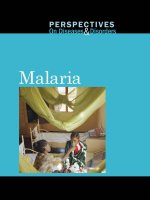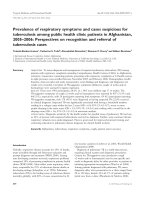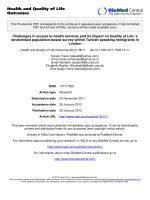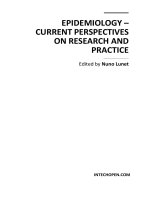Development challenges in bhutan perspectives on inequality and gross national happiness (contemporary south asian studies)
Bạn đang xem bản rút gọn của tài liệu. Xem và tải ngay bản đầy đủ của tài liệu tại đây (3.65 MB, 269 trang )
Contemporary South Asian Studies
Johannes Dragsbaek Schmidt Editor
Development
Challenges
in Bhutan
Perspectives on Inequality
and Gross National Happiness
www.ebook3000.com
Contemporary South Asian Studies
Series editor
Paulo Casaca
Brussels, Belgium
This book series features scientific and scholarly studies focusing on politics,
economics and changing societies in South Asia. Utilizing recent theoretical and
empirical advances, this series aims at providing a critical and in-depth analysis of
contemporary affairs and future developments and challenges in the region. Relevant topics include, but are not limited to, democratization processes, human rights
concerns, security issues, terrorism, EU-South Asia relations, regional and economic cooperation and questions related to the use of natural resources.
Contemporary South Asian Studies (CSAS) welcomes monographs and edited
volumes from a variety of disciplines and approaches, such as political and social
sciences, economics and cultural studies, which are accessible to both academics
and interested general readers. The series is published on behalf of the South Asian
Democratic Forum (Brussels), which is one of the most well-known think tanks in
Europe focusing on South Asia.
More information about this series at />
www.ebook3000.com
Johannes Dragsbaek Schmidt
Editor
Development Challenges
in Bhutan
Perspectives on Inequality and Gross
National Happiness
Editor
Johannes Dragsbaek Schmidt
Department of Political Science
Aalborg University
Aalborg, Denmark
ISSN 2509-4173
ISSN 2509-4181 (electronic)
Contemporary South Asian Studies
ISBN 978-3-319-47924-8
ISBN 978-3-319-47925-5 (eBook)
DOI 10.1007/978-3-319-47925-5
Library of Congress Control Number: 2017934481
# Springer International Publishing AG 2017
This work is subject to copyright. All rights are reserved by the Publisher, whether the whole or part of
the material is concerned, specifically the rights of translation, reprinting, reuse of illustrations,
recitation, broadcasting, reproduction on microfilms or in any other physical way, and transmission
or information storage and retrieval, electronic adaptation, computer software, or by similar or
dissimilar methodology now known or hereafter developed.
The use of general descriptive names, registered names, trademarks, service marks, etc. in this
publication does not imply, even in the absence of a specific statement, that such names are exempt
from the relevant protective laws and regulations and therefore free for general use.
The publisher, the authors and the editors are safe to assume that the advice and information in this
book are believed to be true and accurate at the date of publication. Neither the publisher nor the
authors or the editors give a warranty, express or implied, with respect to the material contained
herein or for any errors or omissions that may have been made. The publisher remains neutral with
regard to jurisdictional claims in published maps and institutional affiliations.
Printed on acid-free paper
This Springer imprint is published by Springer Nature
The registered company is Springer International Publishing AG
The registered company address is: Gewerbestrasse 11, 6330 Cham, Switzerland
www.ebook3000.com
Preface
The ideology of Gross National Happiness reflects the aspirations and hopes of the
people and the elite in Bhutan and has become the modus vivendi in this small landlocked country squeezed between India and China. GNH as it is called is a blueprint
and social experiment for development and has been presented as an alternative to
mainstream strategies. It is also a challenge for those responsible for implementing
economic policies since it may collide with traditional remedies of the state and its
bureaucracy in its endeavours to establish a coherent society and economic growth.
This is a daunting task as the problems related with the implementation of GNH in
some cases may contradict policies intended to create individual creativity, equity
and streamlining culture and tradition at the societal level.
This book represents an attempt to dig into some of the problems inherent in
Bhutan’s development trajectory and explore a range of historical and contemporary issues related to the challenges facing the country. The key question is how the
ruling elite has managed to escape the poverty trap and the chaos seen in some of
the neighbouring countries. Other questions relate to the existing literature which
has a tendency of celebrating GNH at the ideological level but without exploring
the details, problems and contradictions involved. Little is known from independent
scholarship about the status of the implementation of this overarching strategy and
how well it plays out with other sectoral policies, institutions and actors in
Bhutanese society.
The essays contained in this volume provide an opportunity to study nationbuilding and state-building in Bhutan from a critical and interdisciplinary perspective. All contributors have conducted extensive fieldwork in the country, and a few
utilize a comparative theoretical edifice in order to provide a more contextual
approach and understanding of society. The book grew out of an academic collaboration between researchers from Denmark and Bhutan which was generously
funded by the governments of each country. DANIDA, the Danish development
agency, provided the bulk of the funding, and I would like to show my gratitude and
sincere appreciation for this grant. Later on, more high-quality researchers were
invited to give contributions to a workshop where some of the papers have been
discussed, and others joined upon invitation. Opinions expressed are those of the
authors and do not necessarily reflect those of either the funding agencies or the
editor.
v
Map of Bhutan
Map 1 Map of Bhutan. />
vii
www.ebook3000.com
Contents
Development Challenges in Bhutan: Perspectives on Inequality
and Gross National Happiness . . . . . . . . . . . . . . . . . . . . . . . . . . . . . . . . .
Johannes Dragsbaek Schmidt
Part I
Comparing Bhutan’s Development Trajectories
Sociocultural and Political Change in Bhutan Since the 1980s:
Reflections from a Distance . . . . . . . . . . . . . . . . . . . . . . . . . . . . . . . . . . .
Michael Hutt
Donor-Assisted Ethno-nationalism and Education Policy in Bhutan . . . .
Johannes Dragsbaek Schmidt
Part II
1
19
29
GNH, Equality and Inclusion/Exclusion
Gross National Happiness and Inequality . . . . . . . . . . . . . . . . . . . . . . . .
Winnie Bothe
49
Distress Migration and Individual Happiness in Bhutan . . . . . . . . . . . . .
Mahmood Ansari
69
Part III
Culture, Legal Issues and the Politics of Change
A Form of “Democratization Project” in Contemporary Bhutan:
Being Apolitical and Being Religious . . . . . . . . . . . . . . . . . . . . . . . . . . . .
Mari Miyamoto
95
Law, “Tradition” and Legitimacy: Contesting Driglam Namzha . . . . . . 115
Richard W. Whitecross
Part IV
Governance and Integration
Between Hopeful Intentions and Disenchanting Constraints: Lessons
Learned in Bhutan’s Nationwide E-Governance Initiative . . . . . . . . . . . 137
Norbert Wildermuth and Devi Bhakta Suberi
ix
x
Contents
Disaster Governance, Inequality and Poverty Alleviation in Bhutan:
Towards Integrated and Preventive Policies . . . . . . . . . . . . . . . . . . . . . . 171
Caroline Brassard
Part V
Health, Food and Disparities
Regional Disparities and Food Problems in Bhutan . . . . . . . . . . . . . . . . 205
Mahmood Ansari
Policy Synergies in Health-Promoting Education in Bhutan . . . . . . . . . . 235
Johannes Dragsbaek Schmidt and Line Kikkenborg Christensen
Index . . . . . . . . . . . . . . . . . . . . . . . . . . . . . . . . . . . . . . . . . . . . . . . . . . . . 257
www.ebook3000.com
Editor and Contributors
About the Editor
Johannes Dragsbaek Schmidt is Associate Professor at Aalborg University, Denmark. He is
Senior Expert at Nordic Institute of Asian Studies
(NIAS), Copenhagen University, Denmark. He
has held visiting research fellowships in
Australia, Thailand, Malaysia, Indonesia, the
Philippines, and Poland and was recently a
Visiting Professor at the Institute for Political
Economy, Carleton University, Canada. He has
a broad spectrum of research interests, varying
from globalization and international division of
labor to social and welfare policy and state
regulations with a focus on Asia. His most recent
publications: Schmidt, J. D. & Rasiah (2011) The
New Political Economy of Southeast Asia,
London and New York, Edward Elgar Publishing, and Johannes Dragsbaek Schmidt and Jacques Hersh (2002) Globalization and
Social Change, London and New York Routledge.
Contributors
Mahmood Ansari Assam University, Silchar, Assam, India
Winnie Bothe Lund University, Lund, Sweden
Caroline Brassard Lee Kuan Yew School of Public Policy, Tanglin, Singapore
Line Kikkenborg Christensen Department of Political Science, Aalborg University, Aalborg, Denmark
xi
xii
Editor and Contributors
Michael Hutt School of Oriental and African Studies, London University, London,
UK
Mari Miyamoto Keio University, Tokyo, Japan
Johannes Dragsbaek Schmidt Department of Political Science, Aalborg University, Aalborg, Denmark
Devi Bhakta Suberi Department of Communication and Arts, Roskilde University,
Roskilde, Denmark and Sherubtse College, Royal University of Bhutan, Thimphu,
Bhutan
Richard W. Whitecross Honorary Fellow, School of Social and Political Science,
Edinburgh University, Edinburgh, Scotland, UK
Norbert Wildermuth Department of Communication and Arts, Roskilde University, Roskilde, Denmark
www.ebook3000.com
Acronyms
AADMER
ADPC
ADRC
ANMC21
ASEAN
BLSS
BNEW
BYWA
CBHFA
CBDRM
CBDRR
COP
CRED
DDM
DG ECHO
DRR
ECP
EM-DAT
EWS
GAR
GEF
GLOF
GNH
GNHC
HFA
IMF
IPCC
JICA
LDCF
MDG
ASEAN Agreement on Disaster Management and
Emergency Response
Asian Disaster Preparedness Center
Asian Disaster Reduction Center
Asian Network of Major Cities 21
Association of Southeast Asian Nations
Bhutan Living Standards Survey
Bhutan Network for Empowering Women
Bhutan Youth Welfare Association
Community-based health and first aid
Community-based disaster risk management
Community-based disaster risk reduction
Climate Change Conference
Centre for Research on the Epidemiology of Disasters
Department of Disaster Management
Directorate General European Commission’s Humanitarian
Aid and Civil Protection Department
Disaster risk reduction
Environment, climate change and poverty
Emergency Events Database
Early warning system
Global Assessment Report
Global Environment Fund
Glacial lake outburst flood
Gross National Happiness
Gross National Happiness Commission
Hyogo Framework for Action
International Monetary Fund
Intergovernmental Panel on Climate Change
Japan International Cooperation Agency
Least Developed Countries Fund
Millennium Development Goal
xiii
xiv
MoAF
MoEA
MoF
MoFA
MoH
MoHCA
MoIC
MoLHR
MoWHS
NAPA
NCDM
NCWC
NDP
NDRM
NEC
NGO
NPC
PDP
PEI
REAP
RGoB
RMA
SAARC
SB
SDG
SDMC
UNDP
UNEP
UNFCCC
UNICEF
UNISDR
UN-SPIDER
Acronyms
Ministry of Agriculture and Forests
Ministry of Economic Affairs
Ministry of Finance
Ministry of Foreign Affairs
Ministry of Health
Ministry of Home and Cultural Affairs
Ministry of Information and Communication
Ministry of Labour and Human Resources
Ministry of Works and Human Settlement
National Adaptation Programme of Action
National Committee on Disaster Management
National Commission for Women and Children
New Development Paradigm
National Disaster Risk Management
National Environment Commission
Non-governmental organization
National Planning Commission
People’s Democratic Party
Poverty-Environment Initiative
Rural Economy Advancement Programme
Royal Government of Bhutan
Royal Monetary Authority
South Asian Association for Regional Cooperation
Statistics Bureau
Sustainable Development Goal
SAARC Disaster Management Centre
United Nations Development Programme
United Nations Environment Programme
United Nations Framework Convention on Climate Change
United Nations International Children Emergency Fund
United Nations Office for Disaster Risk Reduction
United Nations Office for Outer Space Affairs
www.ebook3000.com
List of Figures
Fig. 1
Role of natural hazards, exposure, vulnerability in disaster
risk . . . . . . . . . . . . . . . . . . . . . . . . . . . . . . . . . . . . . . . . . . . . . . . . . . . . . . . . . . . . . . . . . . . . . . . . . 177
Fig. 1
GNHC 2012 . . . . .. . . . . .. . . . .. . . . . .. . . . .. . . . .. . . . . .. . . . .. . . . . .. . . . .. . . . .. . . . 244
xv
List of Tables
Table 1
Table 1
Table 2
Table 3
Table 4
Table 5
Table 6
Table 7
Table 1
Table 2
Table 3
Table 4
Distribution of rural households in Bhutan: happiness-status-wise,
asset-ownership-wise and region-wise, 2005 (in number
and percentage) . . . . . . . . . . . . . . . . . . . . . . . . . . . . . . . . . . . . . . . . . . . . . . . . . . . . . . . . .
Top ten natural disasters in Bhutan (1985–2011) . . . . . . . . . . . . . . . . . . .
Sector vulnerabilities in Bhutan . . . .. . . . .. . . . .. . . .. . . . .. . . .. . . . .. . . .. . .
Poverty indicators in Bhutan (2003–2012) . . .. . . . .. . . . .. . . . .. . . . . .. . .
Sensitivity and adaptive capacity to adverse effects
of climate change . . . . .. . . . .. . . . .. . . . .. . . . .. . . . .. . . . .. . . . .. . . . . .. . . . .. . . .
Ministries and national agencies: responsibilities relevant
to DRR and poverty alleviation . . . . . . . . . . . . . . . . . . . . . . . . . . . . . . . . . . . . . . .
Annual budget of the Department of Disaster
Management (2010–2014) . . . . . . . . . .. . . . . . . . . . . . .. . . . . . . . . . . . .. . . . . . . . .
GNH index and indicators relevant to disaster risk . . . . . . . . . . . . . . . . .
Governance unit, geographical land and population
particulars in Bhutan: eastern and western regions,
1994 and 2005 . . . . . . . . . . . . . . . . . . . . . . . . . . . . . . . . . . . . . . . . . . . . . . . . . . . . . . . . . .
Annual imports of animal products in Bhutan: 2002 and 2003
(in metric tons) . . . . . . . . . . . . . . . . . . . . . . . . . . . . . . . . . . . . . . . . . . . . . . . . . . . . . . . . .
Agricultural ‘net’ import value of Indian eatable products
in Bhutan: 2000–2003 (in million rupees) . . . . . . . . . . . . . . . . . . . . . . . . . . .
Total imports and exports of agriculture products in Bhutan:
Years, 2000–2003 (in thousand dollars) .. . . .. . .. . . .. . . .. . . .. . . .. . .. . .
88
175
175
178
184
188
190
191
211
225
226
227
xvii
www.ebook3000.com
Development Challenges in Bhutan:
Perspectives on Inequality and Gross
National Happiness
Johannes Dragsbaek Schmidt
The greatest thing that the Buddha has done is to tell the
world that the world cannot be reformed except by the
reformation of the mind of man, and the mind of the world.
(Ambedkar 1956 cf. Lokamitra 2004: 472)
1
Introducing the Issues
In the last decade, the tiny Himalayan Kingdom of Bhutan or Druk Yul—Land of the
Thunder Dragon has received worldwide attention. With a population of 740,000,
landlocked and nestled in between the two giants, India and China, the country has
both topographical, geographical, and infrastructural challenges and beautiful scenery. Despite its low resource base, more than 67 % of the workforce depending on
agriculture, and being one of the world’s smallest economies, Bhutan has achieved
average growth rates of almost 8 % per year since 1996. Overall economic expansion based on exchange earnings from tourism and profits from exports of hydropower electricity generation reveals a fairly positive future scenario. The same
optimism emerges from official figures of social and human development such as
life expectancy that has risen by over 20 years in less than two decades.
The relative success has been explained by at least three salient features: Gross
National Happiness (GNH or gyel yong gakid pelzom) which has replaced GNP as a
measurement of well-being of the individual and the nation. This development
philosophy has received international appraisal, and in June 2012, the United
Nation’s General Assembly voted unanimously in favor of a UN-declared International Day of Happiness as a way to celebrate, generalize, and universalize the
objectives and values behind the promotion of happiness and well-being of all
J.D. Schmidt (*)
Department of Political Science, Aalborg University, Aalborg, Denmark
e-mail:
# Springer International Publishing AG 2017
J.D. Schmidt (ed.), Development Challenges in Bhutan, Contemporary South Asian
Studies, DOI 10.1007/978-3-319-47925-5_1
1
2
J.D. Schmidt
citizens in a secure and peaceful environment. Another explanation refers to the
peaceful transition from absolutist monarchy to democracy exposing the country to
international spotlight as a potential role model of peace and harmony in contrast to
some of its neighboring countries in South Asia, not least Nepal, where a similar
transition has been chaotic, violent, and still contains features of autocratic governance. The third reason is related to Bhutan’s social system. By having a quite
effective free delivery of public social services, not least education and health universally accessible to the whole population, it has become one of the most successful nations in the region in terms of social achievements and an example for others
to follow.
A more intimate look into Bhutan’s recent political-economic and politicalcultural evolution discloses a more nuanced and contradictory picture. GNH, democracy, and the universal delivery of social services have its flaws.
In recent historical perspective, the government’s attempt to create a national
identity based on homogeneity and a uniform political-cultural matrix denoting and
promoting one dominant ideology may be related to the expulsion and marginalization of “the other.” Ethnic nationalism1 has been the denominator, and “collective
exclusiveness” (Smith 1971, 1994: 190) created the space for establishing a discourse relying on ethnic purity and the pretention of cultural affinity or “shared
amnesia” (Gellner 1987: 6) of nonexistence of minorities in general and more
specifically of the Nepali Bhutanese ethnic entity (Hutt 1996: 399–400, 2003). It
is interesting to note the sequence: First step was the denial of Bhutanese citizenship and the subsequent exodus of more than 100,000 Nepali Bhutanese
(Lhotshampas in Dzongkha meaning Southerners). This laid the foundation for
the creation of an “ethnic clean sheet” or in other words Buddhist hegemony and the
royally sanctioned imposition of “one nation, one people” as the overarching ideology of the country. The “one nation, one people” strategy is well described in the
government’s vision 2020: “The emergence of Bhutan as a nation state has been
dependent upon the articulation of a distinct Bhutanese identity, founded upon our
Buddhist beliefs and values, and the promotion of a common language. These have
been defining elements in our history and they have made it possible to unify the
country and to achieve national homogeneity and cohesion among various linguistic and ethnic groups. This identity, manifest in the concept ‘one nation, one
people’, has engendered in us the will to survive as a nation state as well as the
strength to defend it in the face of treats and dangers. It is a unity that binds us all
together and enables us to share a common sense of destiny” (Planning Commission
1999b: 18). There are various disputes about the number of people who left, and
also about the questions, who left voluntarily and who fled the country, but it
remains a fact that many Nepalese Bhutanese have resettled in the United States
and European countries after having spent years in refugee camps in Nepal’s Terai
1
However, all newly emerging states share the same point of departure where nation-building “is
the basic Third World ideology and project. . .” (Smith 1986: 231).
www.ebook3000.com
Development Challenges in Bhutan: Perspectives on Inequality and Gross. . .
3
districts (HRW 2007; Frelick 2011).2 Second step was the introduction of GNH by
the throne as the overall encompassing ideology based on what Johns and Ormerod
(2007: 70) denotes as “at least one country in the world has decided that cultural
homogeneity is a vital part of its citizen’s happiness.” Third step was the gradual
introduction of “guided democracy” under the fifth King Jigme Khesar Namgyel
Wangchuck. Although the backbone of the emerging constitutional democratic
monarchy formally rests on a multiparty system and separation of powers and
check and balances, it is probably more accurate to see it as “democracy by decree”
(Turner et al. 2011) or “a gift from above” (Bothe 2012). But the democratization
process has so far not let to a situation where the multiethnic composition of
Bhutanese society and GNH can be questioned or debated in public.3 This “silence”
and “invisibility” of opposition or competing views is a major characteristic of
present-day politics in Bhutan.
In this way, GNH becomes an ideological instrument utilized by political authorities, i.e., those in power,4 to install one, and only one, development trajectory of the
country leaving virtually no space for opposition, competing discourses or alternative visions for directions of Bhutan’s future. This is of course a contradiction in
itself and can also be interpreted as an antagonism of democracy and pluralism and
attempts to organize interest-based alternatives by societal agents and institutions
(for instance, other ethnic groups, the private sector, or civil society).
Another inherent paradox is the contrast between the promises of GNH that it
upholds strong principles of equality of all human beings by promoting welfare for
the disadvantaged and poor and on the other hand the government provision of free
education and health to the population. In theory, it would inevitably enhance
equity and equality in the country, but the evidence shows the opposite that income
inequality and spatial uneven development especially in rural areas gradually
increase at a quite dramatic rate. If this trend continues, it may undermine the
goals and objectives of GNH as a guiding principle for nation-building and the
transition toward democracy and may indeed threaten the Thimphu-based Drukpa
elite’s grab over the future direction of the country. GNH has become a vehicle for
the transformation of the country away from autocracy toward a hybrid democratic
system, but it remains “monarchical guided” (Wolf 2013) or a “constrained democracy” (Shneiderman and Turin 2012) where the King has informal decision-making
power of last resort in most important decisions related to defense, foreign policy,
2
It is also important to acknowledge that the government and the King in connection with the first
national population census in 1988 was frightened by the number and then decided to “securitize”
the problem as “illegal immigration” and “a serious threat to the Drukpa culture” (Basu 1996: 96).
3
Although the government does recognize the existence of three separate ethnic groups: the
Ngalong, the Lhotshampa, and the Sharchop, officially there is only one national language
Dzongkha (meaning “language of the palace/Dzong”), besides English, which is the language of
administration and medium of instruction in the education system (also Wolf 2013: 8). However,
up to 15 other languages are spoken in the country, and English has become the de facto medium
for cultural and linguistic assimilation.
4
The elite and the King belong to the Ngalong ethnic community, who speak Dzongkha.
4
J.D. Schmidt
the safeguard of GNH, and not least appointment and nomination of government
officials.
Although poverty has been halved and several millennium goals have been
achieved, there still is some dispute about the actual levels of poverty reduction,
and levels of inequality are very worrying (Bhutan News Services, May 8, 2013).
The official figures show that approximately 30 % of the rural population remains
poor, while urban poverty is about 1.5 %, while ADB figures (2013: 2) reveal a
general poverty incidence of 11.5 % in 2012, and there is a widening gap between
the top 10 % and bottom 10 % brackets in Gini income index (Dhakal 2013: 3).
These issues are closely related to the nation-building strategies pursued over the
past decades, the developmental and ideological role of the “organic state,” and the
way education and schooling have been used as overall instruments to enhance
nationalism and national identity. As will become clear, this mixture may run into
problems because of the GNH philosophy’s implicit emphasis on an antidevelopmental ethos (the Middle Path) or what may be termed a “development
dilemma” ensuring culture, environment, and history more than economic progress.
In general, “given the developmental nature of contemporary nation-building
strategies, i.e. dual goal of creating nations and of ensuring self-sufficient growth,
which are so heavily intertwined, any failure in performance for one goal is bound
to diminish the chances in the other” (Smith 1986: 243).
2
Understanding Nation-Building in Bhutan
In order to explain the most important policy changes in Bhutan in recent historical
perspective, it is not unreasonable to claim that they were externally invoked and
not homegrown or conditioned by domestic affairs. Government-sanctioned historiography in Bhutan5 in many cases presents these policy changes as deliberate
individual decision-making and choices made by various benevolent Kings and
advisors, but other research reveals that they were forced by what may be called
geopolitical dilemmas and aggression including war, occupation, and annexation in
Tibet and Sikkim, threats to Buddhism, and the neutralization of monarchies in the
immediate neighborhood (Basu 1996; Gulati 2003). These external events extended
pressure on the monarchy and elite to open the country, introduce economic
reforms, and gradually introduce a political reform process including citizenship
rights to some and none to others, and finally this way make an end to the “ethnic
question” or what the government in some cases in “securitized” terms referred to
as the Southern illegal immigration problem and on other occasions “unnatural
population increase” (UPR 2009: 14; Evans 2010: 29). This also meant an end to a
5
The most important exponent of what may be called “government blueprint” research is to a
certain degree produced by Centre for Bhutan Studies (see, e.g., Ura and Galay 2004; Ura 2013).
An exception to this type of representation is bluntly explained in the key document Bhutan 2020
(Planning Commission 1999b: 8).
www.ebook3000.com
Development Challenges in Bhutan: Perspectives on Inequality and Gross. . .
5
vibrant civil society and political opposition not only among the Bhutanese
Nepalese but also other ethnic groups like the Sharchop. The Bhutanese Nepalese
were perceived by Thimphu as having created havoc, anarchy, and “terror,” and this
reinforced the Drukpa elite’s fear of civil war in Bhutan and the Himalayan region.
Neighboring Tibet, Sikkim, and especially Nepal were perceived as worst-case
scenarios where Buddhism, the monarchy and feudal elite’s power grab, had been
destroyed and occupation and civil war had led to instability.
When this is said, the influential Bhutanese scholar Karma Ura notes that “it has
become somewhat customary to assess issues [in Bhutan, JDS] from the point of
view of security because of the heightened and staunch sense of security in the
country” (2001: 113), and he proposes polemically that “this habit has had a
constructive impact” (ibid). Already in 1993, the then Minister of Home Affairs
Jigme Thinley (who later on became the country’s first elected prime minister)
noted that “The rich and splendorous culture of the Great Wheel of Buddhism,
which once flourished in Sikkim, Tibet, Ladakh, Lahau, and Spiti, is well on the
path of extinction. Today, Bhutan the last bastion of this rich culture, is in a state of
siege,” and he added “that the Drukpas were faced with a real threat to their
survival” (Hazarika 2011: 311). Due to Bhutan’s strategic location, it seems that
geopolitics and security-related issues have had a determining influence on key
decisions over the last century or more. Gulati (2003: 223) refers to a speech by
King Jigme Singye Wangchuck at the fifth SAARC Summit in Maldives in 1990
where he said: “Terrorism has become one of the growing threats to peace and
stability in our region. Even in Bhutan, the spectre of terrorism has intruded on
peace and tranquility that has remained undisturbed.”
Opening up a previously isolated country and economy6 and introducing rather
rapid political and social changes within a few decades was only possible due to the
establishment and accomplishments of what looks like an “organic state” in conjunction with a specific understanding of ethno-nationalism. The way the “organic state”
is defined relies on a romanticized and spiritual conceptualization of territory and the
people. It puts the “collective over the individual” in a sense very much resembling
the way GNH functions in Bhutanese society.7 A nebulous or paternalist notion of
“nation-building” takes on a hegemonic position over individual citizens with specific characteristics that create an identity and a vocabulary which makes it distinguishable in comparison to other nations. This closely follows the design of the East
Asian developmental state as Denman and Namgyel (2008: 488) note that in Bhutan
“. . ..the state, not economic institutions, is the principal shaper of social structures.”
The new nation-building strategy was articulated through the imposition of
6
The term “isolated” may be misleading and a convenient myth since there were trade relations
with India and Tibet going back to the seventh century A.D. (Basu 1996: 14).
7
Here “the organic state” is understood in its original version presented by Plato who “identifies
the interests of the ideal state with the objective interests of the citizens” (Neu 1971: 238).
6
J.D. Schmidt
Dzongkha as national language,8 uniform customs (Driglam Namzha—the Way of
Harmony), an imagined history, new institutions, descent, and Buddhism and was
further exacerbated through the execution of exclusionary moves toward minorities’
cultural and political institutions. The people draw on the historical and ancestral
roots created by the domestic and dominant ethnic (minority) elite and government
representing the “spirit” of the nation, and the roots hold the parts together, melding
the individuals into a whole physical nation in which all the parts are interconnected.
The Bhutanese model is based on an ethnic-cultural matrix or to be more precise
a Mahayana Buddhist state that “assumes primary responsibility for the creation of
a society” (Thinley 1999: 17–18; Mancall 2004: 37). In this version, Drukpa
nationalism was not dependent on the existence of a nation-state but instead
depended on genealogical ties among the Ngalong elite, one vernacular culture
based on two languages, customs based on perceived or invented roots of Drukpa
culture, religion and arts, “a belief in the virtues of indigenous history and its
special interpretation of the history of the nation and its place in the world,” and
a belief in “the people” and the need to mobilize them to create a national identity
(Smith 2008: 17). This is further complemented by well-defined boundaries with a
fixed center—the capital Thimphu—emerging in Bhutan. One legal and political
system disseminated to society and increasingly accepted by consent of the masses.
One mass popular culture and national identity disseminated by means of a public,
standardized education system embedded in GNH as the psychological, mental, and
charismatic political and cultural matrix. The only exception and question is
whether Bhutan has the ability to defend itself (and be recognized by other nations
as being able to do this) and participate in the international community (Smith
2008: 13). The latter is complicated by Bhutan’s dependency on India’s hegemonic
status in the country’s domestic as well as external affairs and India’s financial and
moral support to sustain the model and implicitly accept the ability of the elite to
pursue an alternative on the fringe of its northeastern frontiers.
3
Situating Education as Main Driver for Nationalism
and GNH
A useful way to understand education as the key device for obtaining nationalist
objectives is to differentiate between “primary” and “secondary” nationalism where
the first refers to original nationalism and is concerned with creating national
identity where the latter is meant to preserve and enhance national identity in an
already established nation. Primary nationalism normally attaches enormous
importance to formal education conducted and controlled by the state. The school
and education itself is the most powerful agent for injecting national spirit, “and the
state inculcates national values through formal education. Primary cultural
8
The third King decided already in 1971 that Dzongkha should become the nation’s language, but
its use was reinforced by the government during the uprising by the Bhutanese Nepalese in the
South.
www.ebook3000.com
Development Challenges in Bhutan: Perspectives on Inequality and Gross. . .
7
nationalism usually occurs as part of nation-building which involves the process of
absorbing individuals into the organic state, the politicized aspect of the national
spirit” (Van Horne 1997: 137). In this way, the education system has functioned as
an assimilation mechanism by institutionalizing a state and Drukpa elite monopolized version of ethnicity, and at the same time, the construction of citizenship
has been the major policy device for exclusion. The aim of education is among
other things to instill awareness of the nation’s unique cultural heritage and values,
both traditional and universal (Planning Commission 1999a: 19). In discursive
terms, this objective may be more explicitly defined as Bhutanese citizenship
educational programs as an implicit vehicle for “cultural homogenization” (Bothe
2011: 533) or “Bhutanization” of school curricula which started in the 1980s and
continued in subsequent decades. It was not only a consequence of the deliberations
in Thimphu but came hand in hand with the “nationalization of Heads” with the
result that Bhutanese became headmasters of all schools and a general Bhutanization of curriculum and extracurricular values and cultural activities took place
(Namgyel 2011: 94).9
The government and royal sanctioned GNH Commission have the power to
approve or disapprove all education policies before “they are allowed or enacted”
(Schuelka 2012: 149). This overall guidance and regulation through Bhutanization
and GNH is mirrored in the fact that the dominant view of the elite contemplates
Bhutan in an asymmetric situation “where massive external cultural influences
could literally overwhelm local cultural values when the borders open wide under
the onslaught of globalization—hence the need for a vigorous promotion of indigenous cultures as a context for making available true choice to individuals. We
believe that a state which does not preserve its cultural richness is one where the
choices and well-being of its citizens are diminished and greatly constrained”
(Thinley 2005).
It is also interesting to note that besides the academic skills and functional
objectives of the national curriculum for primary schools, there is almost unilateral
focus on the injection of knowledge about mental and physical health, hygiene, and
social studies, in particular, the geography and history of Bhutan and “a deep sense
of respect and pride in being Bhutanese, and in being citizens who are loyal,
dedicated, productive, contented, and happy with a high standard of morals and
ethics” (Chhoeda 2007: 60). These policies emerged after the closing down of
Nepalese Bhutanese schools in the end of the 1980s leading to more than 30,000
children deprived of education. It also spelled the end of teaching in Nepalese and
the end of Nepalese curriculums in the Bhutanese education system.
The most difficult issue in Bhutan was and is till today how to deal with the
contradictions between state-sanctioned hegemony in education and the reality of a
9
Bhutanization of education came at the same time as the expulsion of the 104,000 Bhutanese
Nepalese in the South and was a follow-up on new citizenship laws, a nationwide census and the
enactment of the Driglam Namzha as a cultural policy aimed at homogenization of traditionalism
with one national uniform dress code and one uniform national architectural design, and public
codes of social conduct.
8
J.D. Schmidt
“multiethnic, multireligious, and multilingual” society (Mathou 2000: 245) and
cultural preservation at the same time. The former Prime Minister Thinley has
stated that Buddhism and education for happiness go hand in hand (Spring 2013:
201), but at the same time, it contradicts the requirements and effects of the
structural or so-called modern British-inspired curriculum and Western skillbased teaching which still overshadow the relatively speaking small cultural
doses coming with GNH formal and informal teaching and curriculum and extracurriculum activities. In this way, the objective of education becomes the assimilation of all cultures into one national culture and identity, a task with daunting
challenges ahead but also probably the only way to create meaning, identification,
and loyalty based on one ethnie (Smith 1986: 237, 243).
Seen from the government’s point of view, education “is the glue that holds the
whole enterprise together” (Thinley 2009: 14) with GNH and happiness understood
not as “a fleeting, pleasurable ‘feel good’ but true abiding happiness cannot exist
while others suffer, and comes only from serving others, living in harmony with
nature, and realizing our innate wisdom and the true and brilliant nature of our own
minds” (ibid). The teacher should be seen as a guru, not just a facilitator: “On the
contrary, a teacher who truly embodies GNH principles and values is also an
authentic and natural authority figure, to whom respect and even reverence are
due” (op cit. 17). By attempting to install such virtues, the idea to promote honor,
valor, loyalty, allegiance, and devotion should be encouraged and be part and parcel
of the educating for GNH values and principles. In one way or the other, the
Bhutanese government attempts to assume the role of an “ethical state” (Basu
1996: 111) or an “organic state” implementing specific moral and cultural ideals
to the people either by force as a control mechanism or preferably by consent.
In fact, one may argue that the original ethno-nationalist Bhutanization strategy
gradually has been replaced with a cultural nationalist direction where education
and the “GNH school” plays the main role in terms of creating a vertical organic
process where women and men and girls and boys interact and influence each other
within a specific social horizontal and localized setting. At the same time, education
becomes the vehicle to effect the “transmission of the cultural heritage from one
generation to the next, as the means of ensuring the historical consciousness of the
people” (Herder cf. Wiborg 2000: 240). The Bhutanese government has changed
both monastic and modern education in an evolutionary manner and implemented a
unifying approach supported by “a ‘nation-culture’ identity that is uniquely preserved by its ruling class” (Denman and Namgyel 2008: 488), and nation-building
has been rather successful if these are the criteria.
4
Development Challenges in Contemporary Bhutan
Bhutan’s socioeconomic development was kick-started in the early 1960s. Since the
“first five-year plan” in 1961, governments have given priority to education and
health and emphasized free delivery in these areas, and in 2008 it became a constitutional right for the people when Bhutan became a democracy. This evolution has
www.ebook3000.com
Development Challenges in Bhutan: Perspectives on Inequality and Gross. . .
9
arisen in tandem with the opening up of the country to outside influences, ideas, and
institutions but always with the King stressing introvert strategies like “self-reliance” (Mancall 2004: 9), and according to the 2008 Constitution, the government
must “secure ecologically balanced sustainable development while promoting
justifiable economic and social development” (RGOB 2008). Although the combination of GNH and probably the best-preserved environment in the world are
laudable, there are several hazards and challenges ahead. Among the most important are those related to the environment and climate change: “High demographic
growth, unplanned urban migrations, increased population density in cities, rapid
rise in imports of cars, and increasing demand for fuel wood, roads, building
construction” (Poissonnier-Lescuras and Gemenne 2013: 7). The environment
and climate related problems are obviously key issues for future generations and
closely related to awareness campaigns and teaching in schools which links well
with GNH ideology.
In the “tenth five-year plan” (2008–2013), the government has made clear that
education and health are still major priorities for the government. According to the
Planning Commission, the population of Bhutan has growing expectations to the
delivery of better quality social services and also a clean environment and disasterfree lifestyle. The government recognizes that investment in education and health
will have both immediate and long-term benefits for the country, and these efforts
may furthermore lead the country into what Mathou (2000: 245) calls “a post-ethnic
consciousness” by “modernizing the minds of the people.” Education and poverty
reduction remains the main objective of government policy and deemed vital for
achieving Bhutan’s socioeconomic goals but is also a mechanism to solve the
inherent contradictions within the ethnie and polity.
Although efficient service delivery to the entire population is still a challenge
due to the physiographical and geographical obstacles, there has been a gradual
shift of focus toward more quality improvement and participatory inclusion not
only in education but also in general due to the democratization process. The area of
health has gone through a similar development, and introduction of ICT is seen as
one way to overcome some of these obstacles.
There are still many constraints facing decision-makers and policy-makers.
Government resources are restrained and dependent on Overseas Development
Assistance (ODA) which needs to be allocated more efficiently and appropriately
to increase quality and especially to link up with the promises of GNH related to
equity and just and fair distribution. ODA is being phased out, and the government
with Prime Minister Tshering Tobgay who took office in 2013 has realized that one
of the main problems has been misuse of public resources in the name of GNH and
even referred to the overemphasis on GNH as distracting awareness and money
away from the real issues related to unemployment, poverty, corruption, and also a
common sense among the general populace that politicians are too remote. He even
denoted himself as a “happiness skeptic” (Hindustan Times, 2 August, 2013).
Key constraints hampering development can be identified within:
10
J.D. Schmidt
• The inability of the government and donors to provide more adequate
infrastructure
• A narrow fiscal base related to fluctuating income from electricity exports to
India and heavy reliance on foreign donors willingness to keep up the provision
of grants and loans
• A miniscule private sector and lack of credit support for small- and mediumscale enterprises
• Price interventions and government regulation hampering competition and
diversification
• A relatively well-functioning primary education and health system but weak and
unequal access to secondary and tertiary, including vocational, training facilities
• A fragile job situation (ADB 2013)
These constraints are furthermore linked to the challenges and expectations from
a better educated and enlightened population toward state-sanctioned development
goals which may or may not collide with the wishes of the so-called Google
generation. Growing inequalities and uneven development may also hamper the
execution of proper government policies, and together this has become a major
burden and challenge for the new democratic political system in Bhutan.
One way to cope with these challenges and constraints is to provide better, more
transparent, and efficient government services across all sectors. More efficient use
of e-governance and information and communications technology (ICT) as a tool
for development, education, and democratization has become an option for the
government but is very expensive and may not necessarily add new jobs as it is also
seen as a way to enhance productivity and efficiency.
5
Aim and Approach of the Book
The objective of this volume is to give an overall critical insight into historical and
contemporary issues related to nation-building, GNH, and inequality understood
not only as a material or socioeconomic term relating to income, assets, land,
resources, health, and gender but also as a political-cultural construct relating to
ethnicity, religion, participation, influence, and collective and individual rights.
Inequality may be related to human capabilities (Sen 1992), durable inequality
(Tilly 1998), existential inequality relating to recognition and redistribution
(Honneth 1995) and respect (Sennett 2002), and intra-ethnic cultural stratification
(Bourdieu 1984).10
What is interesting in a sociological perspective is the focus on how education
impacts mobility, access to the labor market, and class structure. Education as an
institution may be overcome by symbolic violence as its mediating structures
determine the allocation of status and power. Even if education is said to overcome
10
See Therborn (2006).
www.ebook3000.com









